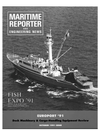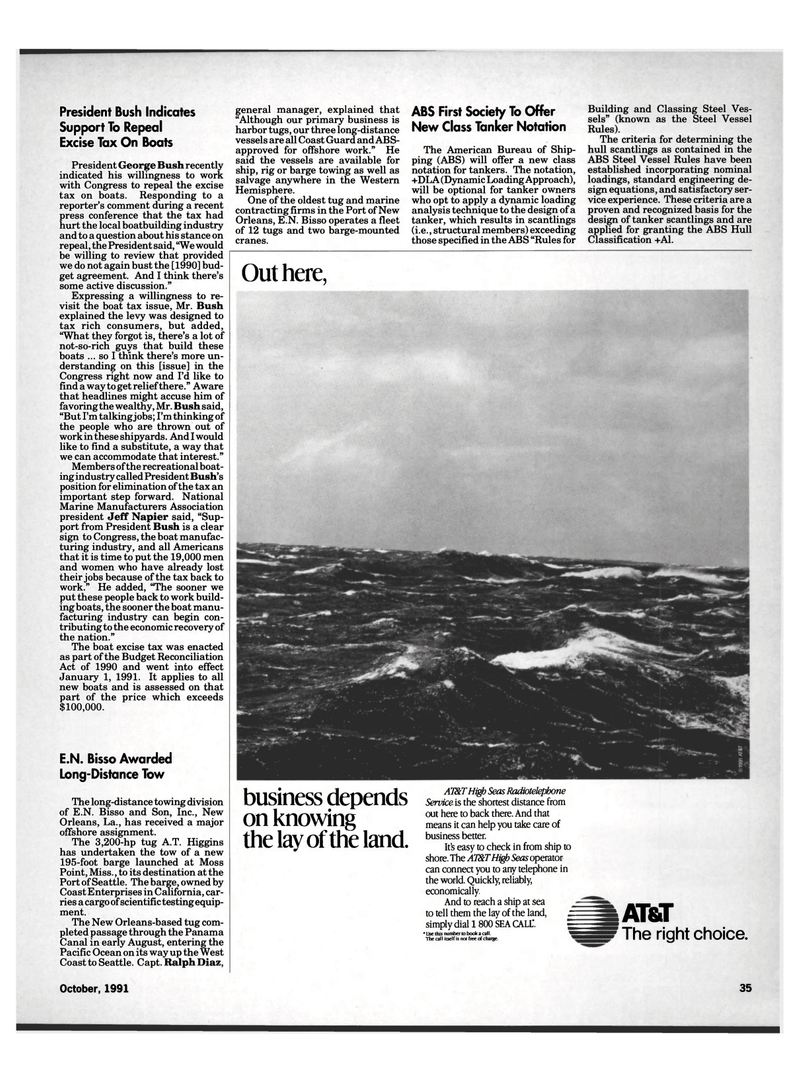
Page 37: of Maritime Reporter Magazine (October 1991)
Read this page in Pdf, Flash or Html5 edition of October 1991 Maritime Reporter Magazine
President Bush Indicates
Support To Repeal
Excise Tax On Boats
President George Bush recently indicated his willingness to work with Congress to repeal the excise tax on boats. Responding to a reporter's comment during a recent press conference that the tax had hurt the local boatbuilding industry and to a question about his stance on repeal, the President said, "We would be willing to review that provided we do not again bust the [1990] bud- get agreement. And I think there's some active discussion."
Expressing a willingness to re- visit the boat tax issue, Mr. Bush explained the levy was designed to tax rich consumers, but added, "What they forgot is, there's a lot of not-so-rich guys that build these boats ... so I think there's more un- derstanding on this [issue] in the
Congress right now and I'd like to find a way to get relief there." Aware that headlines might accuse him of favoring the wealthy, Mr. Bush said, "But I'm talkingjobs; I'm thinking of the people who are thrown out of workin these shipyards. And I would like to find a substitute, a way that we can accommodate that interest."
Members of the recreational boat- ing industry called President Bush's position for elimination of the tax an important step forward. National
Marine Manufacturers Association president Jeff Napier said, "Sup- port from President Bush is a clear sign to Congress, the boat manufac- turing industry, and all Americans that it is time to put the 19,000 men and women who have already lost their jobs because of the tax back to work." He added, "The sooner we put these people back to work build- ing boats, the sooner the boat manu- facturing industry can begin con- tributing to the economic recovery of the nation."
The boat excise tax was enacted as part of the Budget Reconciliation
Act of 1990 and went into effect
January 1, 1991. It applies to all new boats and is assessed on that part of the price which exceeds $100,000.
E.N. Bisso Awarded
Long-Distance Tow
The long-distance towing division of E.N. Bisso and Son, Inc., New
Orleans, La., has received a major offshore assignment.
The 3,200-hp tug A.T. Higgins has undertaken the tow of a new 195-foot barge launched at Moss
Point, Miss., to its destination at the
Port of Seattle. The barge, owned by
Coast Enterprises in California, car- ries a cargo of scientific testing equip- ment.
The New Orleans-based tug com- pleted passage through the Panama
Canal in early August, entering the
Pacific Ocean on its way up the West
Coast to Seattle. Capt. Ralph Diaz, general manager, explained that "Although our primary business is harbor tugs, our three long-distance vessels are all Coast Guard and ABS- approved for offshore work." He said the vessels are available for ship, rig or barge towing as well as salvage anywhere in the Western
Hemisphere.
One of the oldest tug and marine contracting firms in the Port of New
Orleans, E.N. Bisso operates a fleet of 12 tugs and two barge-mounted cranes.
ABS First Society To Offer
New Class Tanker Notation
The American Bureau of Ship- ping (ABS) will offer a new class notation for tankers. The notation, +DLA (Dynamic Loading Approach), will be optional for tanker owners who opt to apply a dynamic loading analysis technique to the design of a tanker, which results in scantlings (i.e., structural members) exceeding those specified in the ABS "Rules for
Building and Classing Steel Ves- sels" (known as the Steel Vessel
Rules).
The criteria for determining the hull scantlings as contained in the
ABS Steel Vessel Rules have been established incorporating nominal loadings, standard engineering de- sign equations, and satisfactory ser- vice experience. These criteria are a proven and recognized basis for the design of tanker scantlings and are applied for granting the ABS Hull
Classification +A1.
Out here, business depends on knowing the lay of the land
AT&T High Seas Radiotelephone
Service is the shortest distance from out here to back there. And that means it can help you take care of business better.
It's easy to check in from ship to shore. The AT&T High Seas operator can connect you to any telephone in the world. Quickly, reliably, economically.
And to reach a ship at sea to tell them the lay of the land, z. simply dial 1 800 SEA CALL". = * Use this number to book a call.
The call itself is not free of charge.
AT&T
The right choice.
October, 1991 35

 36
36

 38
38
